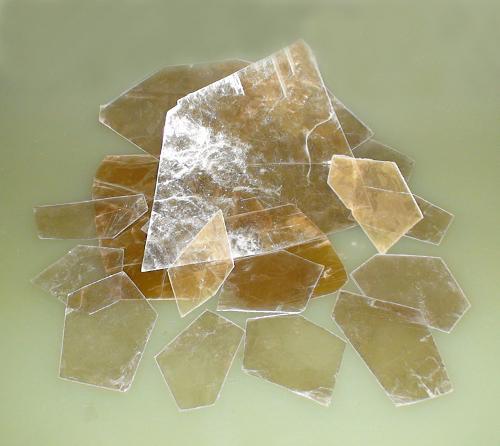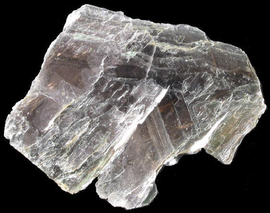What is mica?
Mica, a name that sounds slightly poetic, is actually a type of essential natural silicate mineral in the industrial field. With its unique platy crystal structure and excellent physical properties, it transforms from deep-earth ore into an "invisible cornerstone" in high-tech fields such as new energy, electronics, and rail transit.
From a geological perspective, mica crystals are pseudo-hexagonal platy or tabular, with perfect cleavage—a light scratch with a tool can peel off thin sheets only a few micrometers thick, with a smooth surface and glassy luster. This characteristic stems from its internal layered structure, where each layer is composed of silicon-oxygen tetrahedra and aluminum-oxygen octahedra connected by ionic bonds, maintaining overall stability while giving the flakes flexibility. The most common micas in nature are muscovite, phlogopite, and biotite: muscovite is colorless and transparent, with excellent insulation properties; phlogopite, containing magnesium, is golden yellow and has outstanding high-temperature resistance; biotite, with its high iron content, is mostly dark brown, with slightly weaker insulation but stronger toughness.
Mica Formation: "Time Crystals" of Geological Evolution
The birth of mica is closely related to magma activity and metamorphism deep within the earth, mainly formed through two geological processes:
Magmatic Crystallization
When acidic magma (such as granite magma) deep underground cools slowly, the silicate melt in the magma gradually crystallizes. At temperatures between 600-800℃, potassium, aluminum, and other elements combine under specific pressure (approximately 0.2-0.5 GPa), forming the "seeds" of mica crystals. As the magma continues to cool, these crystals grow continuously, eventually forming large mica crystals in rocks such as granite and pegmatite, some reaching tens of centimeters or even larger.

Metamorphic Regeneration
In regional metamorphism, sedimentary rocks (such as shale) or igneous rocks undergo mineral reorganization under high-temperature (300-500℃) and high-pressure (0.3-1.0 GPa) conditions. Clay minerals (such as kaolinite) in the protolith react with potassium elements released from surrounding rocks, destroying the original crystal structure and recombining into the layered structure of mica. This metamorphically formed mica is mostly distributed in schist and gneiss, with crystals often arranged directionally, forming a unique schistosity structure.

Regardless of the origin, the formation of mica requires a precise "geological recipe": suitable temperature and pressure, sufficient potassium and aluminum supply, and a slow cooling or metamorphic process—this is also the reason why high-quality mica veins are concentrated in specific geological zones (such as Pingjiang, Hunan Province, China, and Rajasthan, India).
Main Uses of Mica: A Versatile Material in Industry
With its diverse and excellent properties, mica has wide and important applications in numerous fields.
1. In the electrical industry, mica is an excellent insulating material. Muscovite, due to its outstanding insulation properties, is widely used in the production of motor and electrical appliance insulation gaskets, insulating sleeves, etc. For example, in the windings of generators, mica tape is wrapped to effectively isolate the current, preventing short circuits and ensuring the safe and stable operation of the motor.
2. In high-temperature industrial scenarios, the high-temperature resistance of phlogopite is fully utilized. In the high-temperature furnace bodies of the metallurgical industry, heat-insulating plates and gaskets made of phlogopite can effectively block heat transfer, reduce energy loss, and protect the furnace structure from high-temperature damage. Mica products are also often used for heat insulation and protection around glass melting furnaces.
3. In the field of new energy vehicles, the role of mica is becoming increasingly critical. In the power battery pack, mica plates are used as a heat insulation layer. When the battery experiences thermal runaway, it can slow down the diffusion of heat, giving the vehicle time for emergency handling and improving battery safety. In addition, mica products can also be found in the insulating components of motors and electronic control systems.
4. In the construction industry, mica can be used to make mica powder coatings. This coating has good weather resistance, wear resistance, and decorative properties. When applied to the exterior walls of buildings, it can protect the walls and beautify the appearance. At the same time, mica flakes can also be added to concrete to improve the crack resistance and durability of the concrete.
5. In the field of electronics and information, specially processed mica flakes can be used to make dielectric materials for capacitors. Due to their high dielectric constant and insulation resistance, they can ensure the stable performance of capacitors. In addition, mica also plays an important role in the insulating components of some precision electronic instruments.
From mineral crystallization in the depths of the earth's crust to key materials on industrial production lines, mica, with its unique formation process, diverse types, and wide range of applications, has become a model of human utilization of natural resources, playing an indispensable role in promoting industrial development and technological progress.
Recommended news








